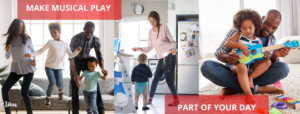A good sense of beat and rhythm are one of the most important gifts you can give your child. Why? Because this helps develop graceful motor flow, by building connections between the rhythms that we hear and the movements that we put together with them. This integration of sound and movement lays the foundation for overall coordination, for skill at sports and in the performing arts, and it leads to the joy of moving, playing and socializing. Music and movement training is so important that it has become integral to therapy for young children with challenges such as ADD/ADHD, developmental delays, cerebral palsy and other motor issues. Researchers have also found that children who can follow the beat in music, and can clap or move to a rhythm are more likely to become good readers.
Where to Begin?
Infants and Toddlers learn these connections through you. As new parents we quickly learn that swaying and  rocking can calm our child, and also what their preferred speed is. We also know that bouncing them, swaying them, or twirling with them will make them joyful. Every culture has songs and games that encourage both these calming moments, as well as the more stimulating ones. Create magical moments with your child by sharing these traditional activities.
rocking can calm our child, and also what their preferred speed is. We also know that bouncing them, swaying them, or twirling with them will make them joyful. Every culture has songs and games that encourage both these calming moments, as well as the more stimulating ones. Create magical moments with your child by sharing these traditional activities.
Put on your favourite music and bounce your child, rock them, pat them, give them that sense of beat. Use the traditional songs that you loved as a child. Make sure to introduce songs with movement vocabulary, such as The Ants Go Marching, while your little one feels the motion together with you. Because these movements are embedded in the lyrics of the song, your child will be able to internalize the patterns, and draw on that experience when he/she becomes mobile.
I Do It Myself!
 Preschoolers want to do things on their own. Help your child develop that sense of steady beat by themselves. Put on music that you both love and keep the beat on some kitchen instruments (pots, pans, lids, plastic containers), table tops, car seats, or any age-appropriate rhythm instrument. We also want our children to feel the beat or the rhythm in their entire body. If you like classical music, there are great songs to use for marching and jumping and twirling, but any music that you enjoy can be used to create a wonderful shared experience with your child. There are also amazing artists who create music especially for children, and incorporate the movement words and activities into their songs.
Preschoolers want to do things on their own. Help your child develop that sense of steady beat by themselves. Put on music that you both love and keep the beat on some kitchen instruments (pots, pans, lids, plastic containers), table tops, car seats, or any age-appropriate rhythm instrument. We also want our children to feel the beat or the rhythm in their entire body. If you like classical music, there are great songs to use for marching and jumping and twirling, but any music that you enjoy can be used to create a wonderful shared experience with your child. There are also amazing artists who create music especially for children, and incorporate the movement words and activities into their songs.
Make Every Day Musical
When life becomes busy and stressful, we often forget that our children learn best through play. Music and movement activities are a great way to incorporate play into your daily routine. Children love structure and predictability, so using a particular song to indicate that it’s time to transition to a required activity can make the day go more smoothly for everyone. Using a specific song to indicate that it’s time to clean up, to come to the table, to go brush our teeth, turns the activity into a recognized game.
You can also incorporate musical movement games into your daily schedule. Words like hop, skip, jump, run,  twirl, tip toe, dance, can be incorporated into any routine task such as going to bed, coming to the supper table, walking through the mall. You can use a single movement word with any song you know, or use a traditional song like The Ants Go Marching. My kids used to love being ants in the grocery aisles. We would march to the milk, jump to the cereal, dance to the fruit and tip toe to the tomatoes. Not only was grocery shopping more fun and engaging, they were always ready for a nap when we were done!
twirl, tip toe, dance, can be incorporated into any routine task such as going to bed, coming to the supper table, walking through the mall. You can use a single movement word with any song you know, or use a traditional song like The Ants Go Marching. My kids used to love being ants in the grocery aisles. We would march to the milk, jump to the cereal, dance to the fruit and tip toe to the tomatoes. Not only was grocery shopping more fun and engaging, they were always ready for a nap when we were done!
If you want to learn more about incorporating musical play into your day, join one of our parent and tot music programs. Our teachers are specialists in early childhood music education, and can help you build a repertoire of games and activities to brighten every day.

